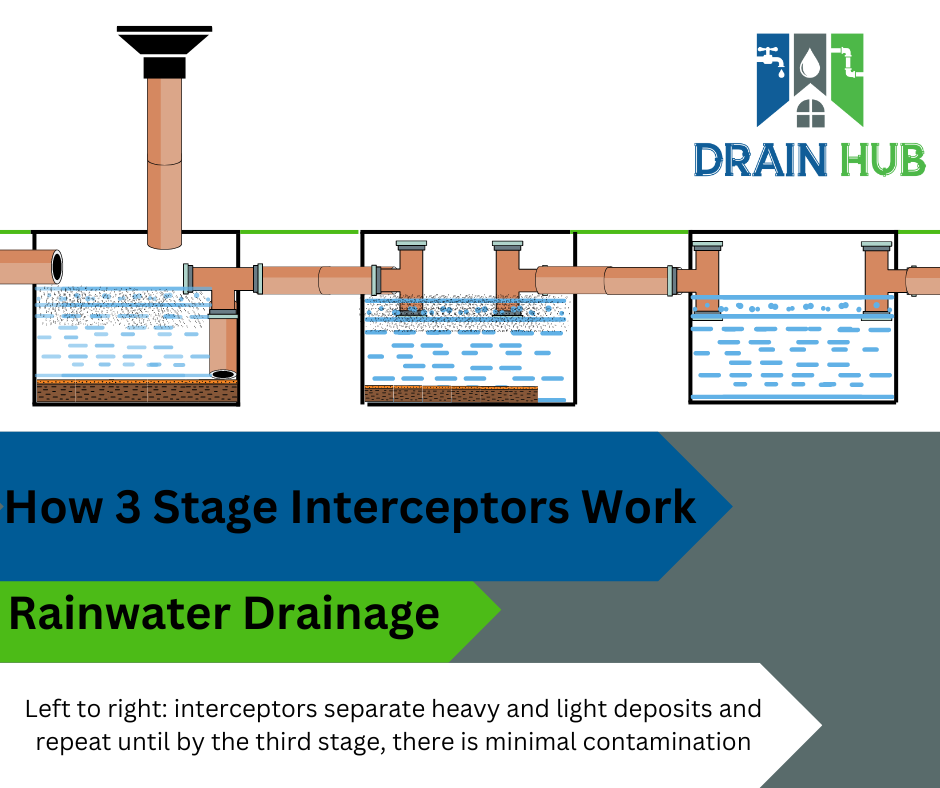Generally used for rainwater systems in car parks and areas where there are heavy amounts of vehicle traffic, interceptors are multi stage chambers used for separating contaminants, both solids and fluids, before the rainwater can move along to its downstream destination; this could be a watercourse of mains drainage system.
It’s extremely important to maintain any interceptors on your property, by regular inspection and emptying and cleaning. Most can be cleaned annually, depending on usage.
Of all the types of external drains in the UK, interceptors can be some of the easiest to identify visually. Being commonly three stages, there are usually three inspection covers, one for each stage.
A three-stage interceptor, also known as a full retention interceptor, helps manage rainwater in UK drainage systems, particularly in areas susceptible to oil and hydrocarbon pollution like car parks, roadways, and industrial sites.
Its primary function is to treat storm, or rainwater runoff before discharging it into the environment or mains sewers.
Here’s How Interceptors Work:
Stage 1: Sedimentation
The first stage focuses on sedimentation.
As rainwater enters the interceptor, it flows into a settling chamber, which is designed to slow down the water flow.
This reduction in velocity allows heavier sediment, debris, and particulate matter to settle at the bottom of the chamber.
Regular maintenance is required to remove these sediments to ensure efficient operation and prevent blockages.
A tanker is the best method of removing this, and you will very likely need a “Consignment Note” from the waste disposal company involved; this is so you have a paper trial in case of any future audits and proves you have been compliant and followed due process with waste and environmental concerns.
Stage 2: Oil Separation
In the second stage, the partially cleaned water moves to the oil separation chamber.
Here, the difference in density between water and oil causes oil, lighter hydrocarbons, and other floating contaminants to rise to the surface.
This chamber is typically equipped with baffles or coalescing devices that enhance the separation process by increasing the surface area for oil particles to coalesce and float to the top. The trapped oil is retained within this chamber, preventing it from flowing into the outlet pipe.
Stage 3: Final Inspection and Coalescence
The third stage is for fine-tuning the cleanliness of the effluent.
This stage often includes additional coalescing filters or similar mechanisms to capture any remaining smaller oil droplets or fine particulates missed by the earlier stages.
The goal here is to ensure that the outgoing water meets environmental standards for non-contaminated water, suitable for discharge into local watercourses or storm sewer systems. It won’t be fully clean, but a lot cleaner than a car park or loading area without an interceptor.
Additional Features
- Flow Control: Most interceptors are equipped with a flow regulator or control device to maintain the flow within the design parameters, ensuring optimal separation efficiency even during heavy rainfall.
- Alarm Systems: Some advanced systems include oil level alarms to alert maintenance personnel when the accumulated oil reaches a certain level, indicating that cleaning is necessary.
- Access Points: For maintenance and inspection, interceptors are designed with manhole covers or access points.
The effectiveness of a three-stage interceptor relies heavily on regular maintenance and proper installation, tailored to the expected levels of contaminants and the scale of water flow. This system not only protects water quality but also helps sites comply with environmental regulations regarding runoff pollution.
It’s worth noting that there are many interceptor products and different designs from different manufacturers, but fundamentally, no matter how complex or simple, the same process is carried out.


Leave a Reply